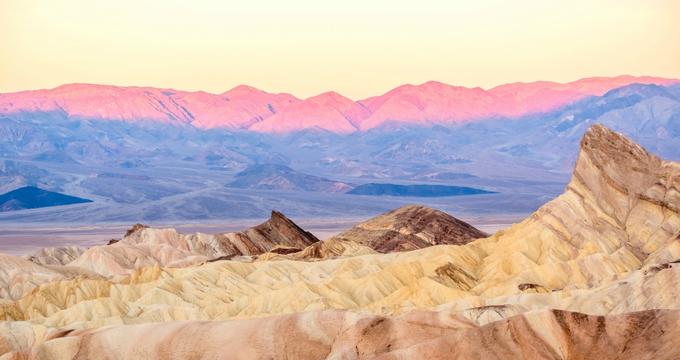" Death Valley National Park is a stark and stunning landscape of extremes straddling eastern California and Nevada. "
Recommended for
- Photographers & Sightseers: Capture jaw-dropping views from Zabriskie Point, Badwater Basin, and Mesquite Flat Sand Dunes.
- Hikers & Explorers: Trek through golden canyons, crater rims, and marble narrows on well-marked trails.
- Science & History Lovers: Discover ancient volcanoes, rare pupfish habitats, and the human history of borax mining.
Highlights
- Badwater Basin: Visit North America's lowest point at 282 feet below sea level, surrounded by surreal salt flats.
- Artist’s Drive: Take a scenic 9-mile route through vibrant sedimentary hills tinted in pinks, greens, and golds.
- Ubehebe Crater: Hike the rim of this half-mile-wide volcanic crater and discover Little Hebe nearby.
- Mesquite Flat Sand Dunes: Explore rippling dunes at sunrise or sunset—just watch out for rattlesnakes!
- Mosaic Canyon: Marvel at marble narrows and colorful breccia rock walls ending in a dry waterfall.
- Salt Creek: Spot the rare desert pupfish, a species adapted to the area’s saline waters.
Visitor Tips
- Stop by the Furnace Creek Visitor Center for maps, a 20-minute film, and ranger advice.
- Plan for extreme conditions—bring plenty of water, sun protection, and wear layered clothing.
- Visit in winter or spring for milder temperatures and occasional wildflowers.
- Use caution in remote areas; cell service is limited and road conditions vary.
Local Vibe
Death Valley is both humbling and exhilarating—a place of contrast where silence speaks loudly and color explodes from arid rock. It invites you to slow down, tune in, and explore a world shaped by extremes. Whether walking among ancient dunes or watching the sky glow over a salt-crusted plain, this desert wilderness leaves a lasting impression.
Contact
Address: Death Valley National Park, Furnace Creek, CA 92328
Phone: 760-786-3200
Website: nps.gov/deva
Plan Your Trip


